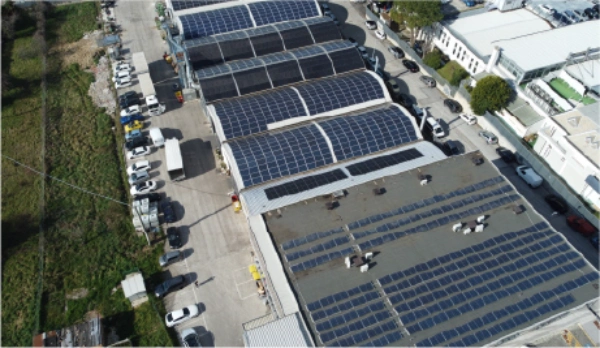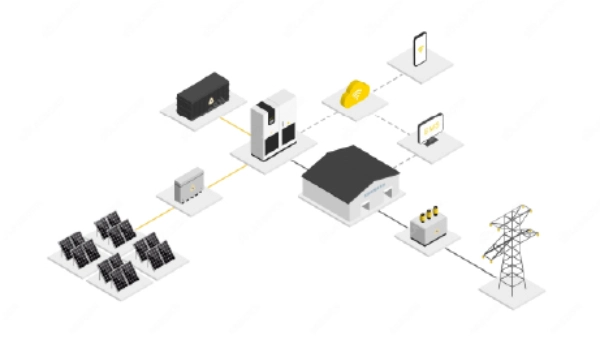Harnessing the power of the sun has long been a dream for those seeking sustainable and renewable energy sources. With advancements in technology, the on-grid PV system has become a reality, enabling individuals and businesses to tap into this abundant resource like never before. In this blog post, we will explore what an on-grid PV system is, how it works, and the numerous benefits it offers. From environmental impact to financial savings, join us as we delve into the advantages of embracing solar power for a brighter and more sustainable future!
What is an On-Grid PV System?
An on-grid PV system, also known as a grid-tied or grid-connected photovoltaic system, is a solar power setup that is directly connected to the electrical grid. Unlike off-grid systems that rely solely on stored energy in batteries, on-grid systems feed excess electricity generated by solar panels back into the grid.
The heart of an on-grid PV system lies in its solar panels, which convert sunlight into usable electricity through the photovoltaic effect. These panels are typically installed on rooftops or open spaces where they have access to maximum sunlight throughout the day.
To ensure seamless integration with the existing electrical infrastructure, an inverter is used in an on-grid system. This device converts the DC (direct current) electricity produced by the solar panels into AC (alternating current), which matches and synchronizes with the utility's voltage and frequency.
By connecting to the grid, users of on-grid PV systems can take advantage of two-way metering. During times when their energy production exceeds consumption, excess electricity flows back into the grid for others to use. Conversely, when their consumption surpasses production capacity, they draw power from the utility company.
This interconnectedness allows for greater flexibility and reliability compared to stand-alone renewable energy setups. Users can benefit from a constant supply of electricity even during times when their solar generation may be insufficient due to weather conditions or increased demand.
An on-grid PV system offers individuals and businesses a sustainable solution that maximizes clean energy generation while still providing access to reliable power from traditional sources as needed. It's a win-win situation for both consumers and our planet!

How Does an On-Grid PV System Work?
An on-grid PV system, also known as a grid-tied or grid-connected solar system, is designed to work in conjunction with the utility grid. This means that it uses both solar power and electricity from the grid to meet your energy needs.
The key component of an on-grid PV system is the solar panels, which convert sunlight into direct current (DC) electricity. The DC electricity is then sent through an inverter, which converts it into alternating current (AC) electricity that can be used by your appliances and devices.
When your solar panels produce more energy than you need at any given time, the excess electricity is fed back into the grid through a process called net metering. This allows you to earn credits for the surplus energy you generate.
During times when your solar panels are not producing enough energy to meet your demand, such as at night or on cloudy days, you can draw power from the utility grid. This seamless transition between solar power and grid power ensures a reliable and constant supply of electricity for your home or business.
By being connected to the utility grid, an on-grid PV system eliminates concerns about running out of power or having insufficient capacity during high-demand periods. It provides flexibility and peace of mind knowing that you have access to clean renewable energy while still being able to rely on traditional sources if needed.
An on-grid PV system offers many advantages over off-grid systems by allowing you to harness sustainable solar power while remaining connected to the reliability of the utility grid.
Benefits of Using Solar Energy
With the increasing focus on sustainability and renewable energy, solar power has emerged as a leading solution to meet our energy needs. Harnessing the power of the sun, solar energy offers numerous benefits for individuals and communities alike.
One of the key advantages of using solar energy is its unlimited availability. As long as there is sunlight, we can generate electricity through photovoltaic (PV) systems. Unlike fossil fuels which are finite resources and contribute to pollution, solar power provides a clean and abundant source of energy.
Solar energy also helps in reducing greenhouse gas emissions. By replacing traditional sources of electricity with solar power, we can significantly decrease our carbon footprint and combat climate change. This not only benefits the environment but also improves air quality, leading to healthier living conditions for all.
Moreover, investing in a solar PV system can result in substantial financial savings over time. By generating your own electricity from sunlight, you reduce or even eliminate your reliance on utility companies. This translates into lower monthly bills and potentially even earning credits by selling excess electricity back to the grid.
Another advantage is that governments around the world are providing incentives and subsidies to encourage the adoption of renewable energy sources like solar power. These financial incentives make it more affordable for homeowners and businesses to install PV systems while promoting sustainable practices on a larger scale.
In addition to these benefits, installing an on-grid PV system also allows you access to reliable electricity supply even during periods when there may be insufficient sunlight available. The surplus power generated during sunny days can be fed into the grid for later use or stored in batteries for backup purposes.
By embracing solar energy through an on-grid PV system, we take a step towards creating a sustainable future powered by clean technology. Not only do we reduce our dependence on non-renewable resources but also contribute towards mitigating climate change effects and fostering economic growth through job creation in the renewable sector.

Environmental Impact and Sustainability
When it comes to harnessing solar power, an on-grid PV system offers significant advantages in terms of environmental impact and sustainability. By utilizing the energy from the sun, we reduce our reliance on fossil fuels and decrease harmful greenhouse gas emissions.
One of the key benefits of using solar energy is that it is a renewable resource. Unlike fossil fuels which are finite and contribute to climate change, sunlight is abundant and can be harnessed indefinitely without negative repercussions. This makes solar power a sustainable solution for meeting our energy needs both now and in the future.
Another important environmental aspect of on-grid PV systems is their minimal water usage compared to traditional power sources like coal or nuclear plants. Solar panels require very little water for maintenance, reducing strain on local water supplies and ecosystems.
Furthermore, by choosing an on-grid system, you contribute towards creating a more decentralized electricity grid. This means less dependence on centralized power stations that often rely on non-renewable resources or produce pollution as byproducts.
In addition to mitigating pollution and reducing carbon emissions, installing an on-grid PV system also helps combat air pollution. Traditional methods of generating electricity release pollutants such as sulfur dioxide, nitrogen oxide, particulate matter into the atmosphere which can have detrimental health effects. Switching to solar power reduces these harmful emissions significantly.
Financial Savings and Incentives
One of the biggest advantages of installing an on-grid PV system is the potential for significant financial savings. By generating your own electricity from solar power, you can drastically reduce or even eliminate your monthly energy bills. Imagine being able to channel that money towards other important aspects of your life!
Additionally, many governments and utility companies offer various incentives to encourage homeowners to adopt renewable energy systems like on-grid PV systems. These incentives can come in the form of tax credits, rebates, grants, or even net metering programs.
Tax credits allow you to deduct a portion of the cost of your solar installation from your income taxes. This means extra money in your pocket at tax time! Rebates provide a direct cash incentive for investing in renewable energy technology.
Grants are another avenue worth exploring as they can help offset some of the upfront costs associated with purchasing and installing an on-grid PV system.
Net metering is a program offered by many utilities that allows you to receive credit for any excess electricity generated by your solar panels. During periods when you produce more electricity than you consume, this excess power gets sent back into the grid and credited to your account. You can then use these credits during times when demand exceeds supply.
Before deciding whether an on-grid PV system is right for you financially, it's crucial to consider factors such as local regulations regarding incentives and financing options available in your area.
Solar power not only offers environmental benefits but also provides compelling financial advantages through ongoing savings and generous incentive programs! So why not take advantage? Harnessing solar power with an on-grid PV system could lead you towards a brighter future both economically and sustainably!
Factors to Consider Before Installing an On-Grid PV System
1. Sunlight Availability: The amount of sunlight your location receives is crucial for the efficiency of a solar panel system. It's important to assess whether your area receives enough sunlight throughout the year to generate sufficient electricity.
2. Roof Orientation and Angle: The orientation and angle of your roof can impact the performance of solar panels. Ideally, roofs that face south with a tilt between 30-45 degrees tend to yield optimal results.
3. Roof Condition: Before installing solar panels, it's essential to ensure that your roof is in good condition and able to support the additional weight without any structural issues.
4. Energy Consumption: Take into account your household or business energy consumption patterns. Understanding how much electricity you use will help determine the size and capacity of the solar panel system needed.
5. Financial Considerations: While investing in an on-grid PV system offers long-term financial benefits, it's important to evaluate upfront costs, financing options, and potential return on investment based on local electricity rates and available incentives.
6. Grid Connection Policies: Research local regulations regarding grid connection policies and net metering programs that allow you to sell excess electricity back to the grid for credits or monetary compensation.
By considering these factors before installing an on-grid PV system, you can make informed decisions about harnessing solar power for a sustainable future.
Conclusion: A Bright Future with Solar Power
The adoption of on-grid PV systems for harnessing solar power is not just a trend; it's a step towards building a sustainable future. As we have explored in this article, these systems offer numerous advantages, from reducing our environmental impact to providing financial savings and incentives.
By utilizing the abundant energy from the sun, on-grid PV systems help us reduce our dependence on fossil fuels and decrease harmful emissions. This shift towards cleaner energy sources is crucial in combating climate change and preserving our planet for future generations.
Moreover, the financial benefits of installing an on-grid PV system cannot be overlooked. From lower electricity bills to potential incentives and rebates, homeowners can save money while making a positive impact on the environment. The return on investment may take some time but considering the long lifespan of solar panels, it becomes clear that they are worth every penny.
However, before deciding to install an on-grid PV system, it's important to consider factors such as location-specific weather conditions and available space. Conducting thorough research and consulting with professionals will ensure you make an informed decision that suits your specific needs.
In conclusion, embracing solar power through on-grid PV systems offers immense benefits both environmentally and financially. With advancements in technology and increasing awareness about renewable energy sources, we can look forward to a brighter future where solar power plays a significant role in meeting our energy needs sustainably.
So why wait? Let's join hands in harnessing the power of the sun today! Together, we can create a greener world for ourselves and generations to come.
Wesley Wu
sales@solarborn.com


